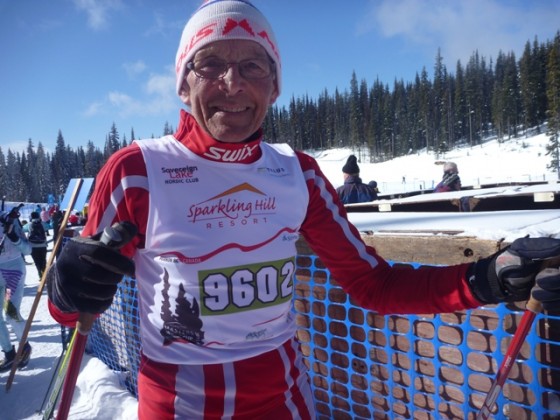
Welcome back to This Month in Journals, where we read the latest exercise and sports science and pull out some research that might be of interest to skiers.
– Gentlemen of the ski world, some good news: if you started out as an athlete young, it will likely help you in your old age. Dr. Magnus Tveit and his colleagues at Lund University in southern Sweden have completed a cohort study of over 2000 men and concluded that once you hit your 70’s, ex-athletes have a much lower risk of breaking bones.
“This study, currently the largest retrospective matched controlled cohort study published, with the aim at estimate any fracture and fragility fracture incidence in old former athletes, shows a 50% lower risk of sustaining fragility fractures in athletes after career end than would be expected with age,” Tveit et al. wrote in Medicine and Science in Sports and Exercise.
However, the team was unable to completely parse why this might be true. Exercising when you’re growing up increases bone mass, yet it’s unclear whether better bone mass density is maintained after an athlete retires, or for how long. Exercise can also increase bone size, which would independently reduce fracture risk. And are athletes more likely to risk traumatic injuries? How does that fit into the picture?
The researchers also admitted that they would like to work with an even older age group in the future. After the age of 50, rates of hip fractures roughly double every five years; they weren’t sure whether the pattern of fewer broken bones would hold for hips as well. They added that doing sports has an effect on the amount and type of soft tissue in hips and knees, which may interact with the bone qualities themselves to change fracture rates – for better or for worse.
Regardless of the causes, the team was confident in their conclusion: men who are former athletes are less likely to find themselves wrapped up in plaster casts when they hit the golden years.
– Ladies, don’t worry, we’re not left out. And this reporter believes that the conclusions from the previous study are likely applicable to women too, at least to some extent; one main problem with including women was the difficulty of finding hundreds of septuagenarian ex-elite athletes to study. The group of men had been gleaned from a Swedish Olympic Committee book about former athletes, and at the time when the men were competing there were far fewer women in the highest levels of sports than there are today.
But another team looked at a different aspect of aging, and how it affected men and women who exercise. Dr. Michael Deschenes of the College of William and Mary wrote that in young or even middle-aged athletes, men and women metabolize different energy sources with differing levels of efficiency; men gain muscle faster while women lose it faster when they stop exercising; and women seem to maintain stability better during endurance tasks.
Previous studies had compared young and old men, or young and old women, but this was one of the first to directly compare old men and women, the authors claim. In the American Journal of Human Biology, Deschenes and his team reported that sexual dimorphism disappeared in his older group of test subjects, who had a mean age of 70 years. Of the multiple variables investigated, not one varied by sex.
To be clear, the test subjects weren’t all the same: the men still had higher VO2Max scores and more muscle mass. But once they started exercising, men’s and women’s cardiovascular, thermoregulatory, metabolic, and circulatory systems behaved in more or less the same way.
That means that masters can all follow the same training plan – and ladies, do we have some hope of beating the guys? (Probably not – pesky muscle mass. We’ll have to work on our technique.)
– Lots of attention has been focused recently on the effect of exercise on heart health. A year and a half ago, we wrote about a study that used cohort data from the Vasaloppet to show that lifelong skiers were at a higher risk of heart arrhythmias. Bradycardia, as the arrhythmias are called, go along with a syndrome called “athlete’s heart.”
And yet many of the symptoms of athlete’s heart were linked to the left side of the organ itself; for instance, the left ventricle typically enlarges and the heart walls of that chamber become thicker.
But last month, the discussion widened. First a team from Strasbourg, France, reported on cases of atrioventricular (AV) block in two 56-year-old triathletes; these were just the second and third cases of such blocks, which occur when the conduction of the electrical signal in the heart is stopped, having been brought on by exercise (in the athlete’s heart syndrome, these AV blocks disappear when exercise is begun).
Writing in Medicine and Science in Sports and Exercise, they concluded that these types of blocks did in fact happen to athletes, and since there is little clinical precedent to go on, should be handled carefully.
Meanwhile, an Italian team led by Dr. Antonello D’Andrea, the head of the Cardiology division at the Second University of Naples, widened their own scope by looking at the right side of the heart instead of the left. And they did so with impressive attention to detail, comparing 395 top-level endurance athletes to 225 strength-trained competitors. In the International Journal of Cardiology, D’Andrea and his associates wrote that the “right heart,” too, experiences changes.
Using echocardiography, they found that both the right ventricle and right atrium were larger in endurance athletes than strength athletes, with both groups being larger than non-athletes. They also found a correlation between left ventricle stroke volume and the dimensions of the right side of the heart, showing that the chambers grow in cooperation. The team believes it has now defined the “upper limits” of the dimensions of an athlete’s heart.
– A few weeks ago, we wrote about scientists who are looking for the genes that determine how an individual responds to endurance training. Well, the March edition of Annals of Human Genetics included an update from a different team, which used a different group of individuals – this time just 60 women – to identify 39 genes which seemed to be differentially expressed in the individuals who responded best to training. This confirms not only the work, but the concept of the previous research.
This Month in Journals is our occasional series surveying the world of sports science and trying to extract tidbits of research that might be of interest to the skiing public. Previous editions can be found here: February, January, December, October, and September.
Chelsea Little
Chelsea Little is FasterSkier's Editor-At-Large. A former racer at Ford Sayre, Dartmouth College and the Craftsbury Green Racing Project, she is a PhD candidate in aquatic ecology in the @Altermatt_lab at Eawag, the Swiss Federal Institute of Aquatic Science and Technology in Zurich, Switzerland. You can follow her on twitter @ChelskiLittle.



5 comments
Tim Cowan
April 4, 2013 at 10:19 am
Thanks Chelsea.
In para. 7 you mention: “…and women seem to maintain stability better during endurance tasks.”
What type of “stability” are we talking about here?
Chelsea Little
April 4, 2013 at 10:27 am
Sorry, I should have been more clear: thermoregulatory/homeostasis.
sameb
April 4, 2013 at 10:37 am
wow. Chelsea. You assume a lot of knowledge on your readers’ part here when it comes to this heart research. I think a lot of people who have known life-long athletes who have died of heart attacks during exercise are concerned about the arrhythmia research and what it means for our lifestyle. I’ve got to say that having read through this section twice, with zero medical background, it’s totally meaningless to me. What the heck is an AV block? Is it the heart stopping? What does it mean that the right chamber also gets bigger in athletes’ hearts? Should that make me feel more or less concerned? Is the research still too new to draw conclusions? Help a lay-brother out here.
Chelsea Little
April 4, 2013 at 11:15 am
Hi Sam,
I am sorry to disappoint you. If you visit our previous article (which I linked to: http://fasterskier.com/article/lifelong-skiers-show-increased-risk-of-developing-heart-arrhythmias/) the athlete’s heart syndrome is explained, including the basis of arrhythmias and what an AV block is. The results mentioned here are in many ways an update on the existing research, but the authors do not offer any specific recommendations about risk or how to address these concerns. For instance, with the exercise-induced AV blocks, it’s great to know that this happens – but with a sample size of two, few conclusions can be drawn about how to handle them, other than carefully!
In science we say that some of the greatest discoveries are made simply out of curiosity. I would say that both of the heart studies I described are in the “gathering knowledge” phase and not the “applications” phase.
cheers,
Chelsea
mandlim
April 4, 2013 at 7:29 pm
Chelsea:
Great summary article. Appreciate the abstracts and the style of presentation.
Mike